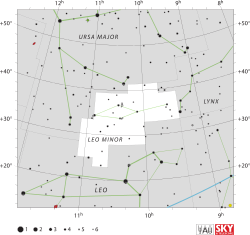21 Leonis Minoris
| 21 Leonis Minoris | |
 | |
| Observationsdata Epok: J2000.0 | |
|---|---|
| Stjärnbild | Lilla lejonet |
| Rektascension | 10t 07m 25,76296s[1] |
| Deklination | +35° 14′ 40,8965″[1] |
| Skenbar magnitud () | +4,47 – 4,52 (V)[2] |
| Stjärntyp | |
| Spektraltyp | A7 V[3] |
| U–B | +0,08[4] |
| B–V | +0,18[4] |
| Variabeltyp | Delta Scuti-variabel[2] |
| Astrometri | |
| Radialhastighet () | -11,40 ± 0,9[5] km/s |
| Egenrörelse (µ) | RA: +52,90[1] mas/år Dek.: +0,62[1] mas/år |
| Parallax () | 35,41 ± 0,18[1] |
| Avstånd | 92,1 ± 0,5 lå (28,2 ± 0,1 pc) |
| Absolut magnitud () | +2,43[5] |
| Detaljer | |
| Radie | 1,2 - 1,8[6] R☉ |
| Luminositet | 10,6[7] L☉ |
| Temperatur | 7 839[8] K |
| Metallicitet | -0,01 (Fe/H)[8] dex |
| Vinkelhastighet | 155[9] km/s |
| Ålder | 390[9] miljoner år |
| Andra beteckningar | |
| 21 Lmi, AG+35 991, BD+35 2110, FK5 2812, GJ 9314, GJ 378.3, GSC 02509-01343, HD 87696, HIC 49593, HIP 49593, HR 3974, IRAS 10044+3529, 2MASS J10072573+3514409, NSV 4736, PPM 75005, SAO 61874, TD1 14563, TYC 2509-1343-1, uvby98 100087696, WISE J100725.82+351441.5, Gaia DR2 747570290871415680 [10] | |
21 Leonis Minoris, som är stjärnans Flamsteed-beteckning, är en ensam stjärna, belägen i den södra delen av stjärnbilden Lilla lejonet. Den har en genomsnittlig skenbar magnitud av ca 4,50[2] och är svagt synlig för blotta ögat där ljusföroreningar ej förekommer. Baserat på parallaxmätning inom Hipparcosuppdraget på ca 35,4[1] mas, beräknas den befinna sig på ett avstånd på ca 92 ljusår (ca 28 parsek) från solen. Den rör sig närmare solen med en heliocentrisk radialhastighet på ca -11 km/s[11] och antas ingå i Sirius superhop.[5]
Egenskaper
21 Leonis Minoris är en vit till blå stjärna i huvudserien av spektralklass A7 V.[3] Den har en radie som är 1,2 – 1,8[6] solradier och utsänder från dess fotosfär ca 11[7] gånger mera energi än solen vid en effektiv temperatur av ca 7 800[8] K.
21 Leonis Minoris roterar snabbt med beräknade projicerad rotationshastighet av 155 km/s.[9] Den har listats som snabbroterande standardstjärna för spektraltypen av A7 V, i motsats till den långsamt roterande standardstjärnan 2 Hydrae.[12] Den är också en Delta Scuti-variabel med en skenbar magnitud som varierar från 4,47 till 4,52.[2] 21 Leonis Minoris har ett överskott av infraröd strålning, vilket tyder på förekomst av en omgivande stoftskiva.[9]
Se även
Referenser
- Den här artikeln är helt eller delvis baserad på material från engelskspråkiga Wikipedia, 21 Leonis Minoris, 23 april 2020.
Noter
- ^ [a b c d e f] van Leeuwen, F.; et al. (2007). "Validation of the new Hipparcos reduction". Astronomy and Astrophysics. 474 (2): 653–664. arXiv:0708.1752. Bibcode:2007A&A...474..653V. doi:10.1051/0004-6361:20078357.
- ^ [a b c d] Samus, N. N.; Durlevich, O. V.; et al. (2009). "VizieR Online Data Catalog: General Catalogue of Variable Stars (Samus+ 2007-2013)". VizieR On-line Data Catalog: B/gcvs. Originally Published in: 2009yCat....102025S. 1. Bibcode:2009yCat....102025S.
- ^ [a b] Johnson, H. L.; Morgan, W. W. (1953). "Fundamental stellar photometry for standards of spectral type on the revised system of the Yerkes spectral atlas". The Astrophysical Journal. 117: 313. Bibcode:1953ApJ...117..313J. doi:10.1086/145697.
- ^ [a b] Johnson, H. L. (1966). "UBVRIJKL Photometry of the Bright Stars". Communications of the Lunar and Planetary Laboratory. 4: 99. Bibcode:1966CoLPL...4...99J.
- ^ [a b c] Eggen, Olin J. (August 1998), "The Sirius Supercluster and Missing Mass near the Sun", The Astronomical Journal, 116 (2): 782–788, Bibcode:1998AJ....116..782E, doi:10.1086/300465.
- ^ [a b] Pasinetti Fracassini, L. E.; et al. (2001). "Catalogue of Apparent Diameters and Absolute Radii of Stars (CADARS) - Third edition - Comments and statistics". Astronomy & Astrophysics. 367 (2): 521–24. arXiv:astro-ph/0012289. Bibcode:2001A&A...367..521P. doi:10.1051/0004-6361:20000451.
- ^ [a b] https://www.universeguide.com/star/21leonisminoris. Hämtad 2020-04-23.
- ^ [a b c] Gray, R. O.; Corbally, C. J.; Garrison, R. F.; McFadden, M. T.; Robinson, P. E. (2003). "Contributions to the Nearby Stars (NStars) Project: Spectroscopy of Stars Earlier than M0 within 40 Parsecs: The Northern Sample. I". The Astronomical Journal. 126 (4): 2048. arXiv:astro-ph/0308182. Bibcode:2003AJ....126.2048G. doi:10.1086/378365.
- ^ [a b c d] Rieke, G. H.; Su, K. Y. L.; Stansberry, J. A.; Trilling, D.; Bryden, G.; Muzerolle, J.; White, B.; Gorlova, N.; Young, E. T.; Beichman, C. A.; Stapelfeldt, K. R.; Hines, D. C. (2005). "Decay of Planetary Debris Disks". The Astrophysical Journal. 620 (2): 1010. Bibcode:2005ApJ...620.1010R. CiteSeerX 10.1.1.579.8956. doi:10.1086/426937.
- ^ "* 21 LMi". SIMBAD. Centre de données astronomiques de Strasbourg. Hämtad 23 april 2020.
- ^ Gontcharov, G. A. (2006). "Pulkovo Compilation of Radial Velocities for 35 495 Hipparcos stars in a common system". Astronomy Letters. 32 (11): 759–771. arXiv:1606.08053. Bibcode:2006AstL...32..759G. doi:10.1134/S1063773706110065.
- ^ Gray, R. O.; Garrison, R. F. (1989). "The late A-type stars - Refined MK classification, confrontation with Stromgren photometry, and the effects of rotation". The Astrophysical Journal Supplement Series. 70: 623. Bibcode:1989ApJS...70..623G. doi:10.1086/191349.
Externa länkar
Media som används på denna webbplats
Författare/Upphovsman: IAU and Sky & Telescope magazine (Roger Sinnott & Rick Fienberg), Licens: CC BY 3.0
IAU Leo Minor chart, modified with Flamsteed stars that are part of asterism added.


